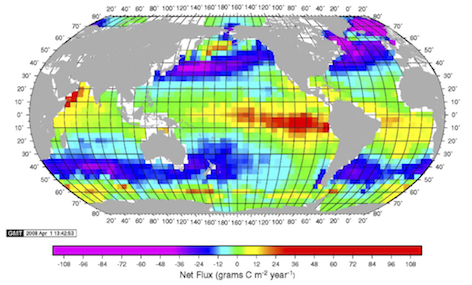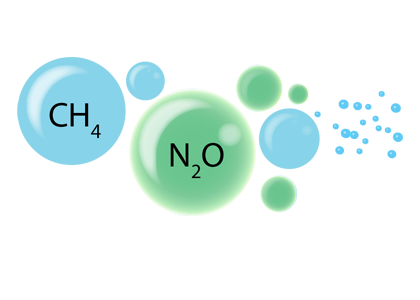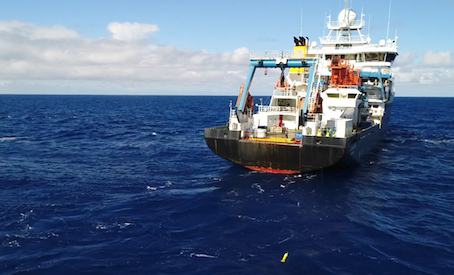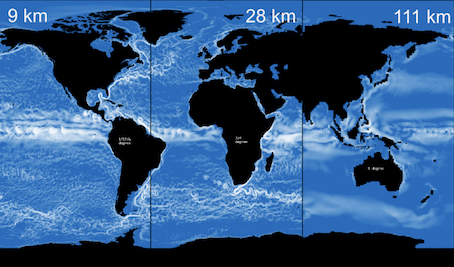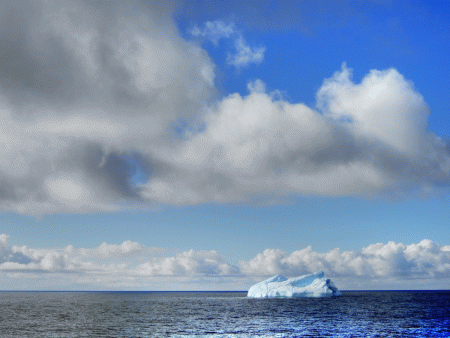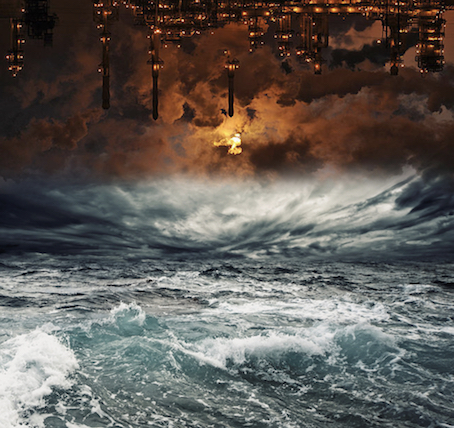Greenhouse Gases in the Oceans
The oceans are a major sink of anthropogenic carbon dioxide (CO2). We need to understand the mechanisms of gas exchange at the air-sea interface and the factors that influence these mechanisms, as well as ocean chemistry and the “carbon pumps”, i.e. the processes that transport carbon from the surface to the deep ocean: the inorganic “solubility pump” and the “biological carbon pump”. 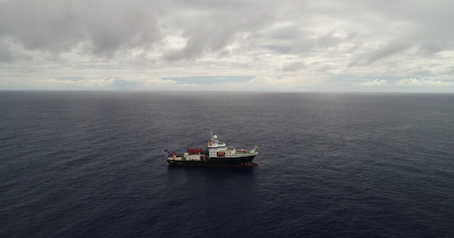
Observing and measuring these processes poses particular challenges, as the world oceans are vast and research cruises are very complex and expensive. Understanding the possibilities and limitations of marine observations also helps to put ocean modelling approaches into context.
Besides CO2 and the carbon cycle, oceans also contribute to other greenhouse gases to a lesser extent. Hotspots of methane (CH4) and nitrous oxide (N2O) production exist in some ocean regions, but observations are much more sparse than for CO2, and our understanding of relevant processes much poorer.
Carbon Dioxide and the Ocean Carbon Cycle
The Ocean Carbon Cycle
Prof Andrew Watson (University of Exeter)
This presentation gives a very brief introduction to everything about carbon in the ocean: the basic chemistry, ocean "carbon pumps", the different methods of calculating the ocean sink for atmospheric CO2, gas exchange at the air-sea interface, and the big quantities that are still unknown.
[Andrew Watson: The Ocean Carbon Cycle I (Content not currently available)]
[Andrew Watson: The Ocean Carbon Cycle II (Content not currently available)]
Biological Components of the ocean carbon cycle
Dr Stephanie Henson (National Oceanography Centre, Southampton)
This lecture focusses on aspects of the ocean carbon cycle associated with biological activity, principally known as the “biological carbon pump”. It covers the importance of the biological carbon pump in the global carbon cycle and some of the components that make up the pump. We will learn when and where biological activity dominates the ocean uptake of CO2, and what happens to that carbon once it has entered the ocean. Finally, we discuss the anthropogenic influence on the biological carbon pump.
[Stephanie Henson: Biological components of the ocean carbon cycle (PDF, 2.5Mb)]
Non-CO2 Greenhouse Gases
The Role of non-CO2 Greenhouse Gases in the Ocean
Prof Jan Kaiser (University of East Anglia)
This presentation looks at the role of the non-CO2 greenhouse gases methane (CH4) and nitrous oxide (N2O) in the ocean, their distribution, production mechanisms and measurement techniques.
Nitrous oxide is produced as intermediate and/or byproduct of microbial denitrification and nitrification, mostly under low (but not anoxic) oxygen concentrations. Oceanic N2O emissions contribute about 25 % to total N2O production, predominantly from upwelling zones in Pacific and Atlantic, the Arabian Sea and some coastal areas.
Oceanic methane is usually close to equilibrium with the atmosphere and total emissions amount to less than 5 % of anthropogenic fluxes. The majority of methane is likely to form in anoxic microzones (fecal pellets, detritus, zooplankton guts) in highly productive areas, especially estuaries and coastal areas. However, methane supersaturations in oxygenated surface waters (the "marine methane paradox") may also be caused by aerobic methylphosphonate decomposition.
Climate change,deoxygenation, ocean acidification, nutrient supplies and circulation are all thought to be important factors influencing future oceanic N2O and CH4 emissions.
[Jan Kaiser: Non-CO2 Greenhouse Gases (Content not currently available)]
Marine observation systems
From GO-SHIP to GLODAP, from VOS to SOCAT, Argo: Sustained Ocean Measurements
Dr Brian King (National Oceanography Centre, Southampton)
The very best measurements of carbon-related parameters in the ocean are made by having experienced analysts present to operate state of the art analytical instruments. But you can’t have people everywhere, all the time, so we also use automated systems, to provide data coverage that would be impossible with attended systems.
Systematic global measurements of the subsurface ocean from research ships began with WOCE and JGOFS in the 1990s, and are now co-ordinated by GO-SHIP. The carbon data from those cruises are assembled and quality-controlled by the GLODAP community. The GLODAP products include discrete sample data and gridded maps.Sustained ocean surface measurements are made by volunteer observing ships, with the data assembled by the SOCAT partners. Both the GLODAP and SOCAT activities involve systematic quality control of the original data, for the purpose of producing consistent, high-quality databases.
Argo floats have provided global, year-round measurements of the physical properties of the ocean.
Floats with sensors relevant to biogeochemistry, including oxygen, chlorophyll fluorescence, nitrate, pH are being deployed in regional pilot arrays. If robust and stable sensors can be demonstrated, this could grow into a global array.
[Brian King: From GO-SHIP to GLODAP (Content not currently available)]
Further information:
- GO-SHIP [http://www.go-ship.org]
- GLODAP [http://cdiac.ornl.gov/oceans/GLODAPv2]
- SOCAT [http://www.socat.info]
- Argo [http://www.argo.ucsd.edu]
Ocean Modelling
Ocean modelling
Dr Kevin Oliver (University of Southampton)
Ocean and climate models are key tools for understanding the present carbon cycle and projecting future changes, but these models also exhibit strong discrepancies with observations.
[Kevin Oliver: Ocean Modelling (Content not currently available)]
The Changing Ocean
The glacial-interglacial CO2 problem
Dr Kevin Oliver (University of Southampton)
Atmospheric CO2 concentrations from ice-core records are well correlated with Antarctic temperature on glacial-interglacial timescales. Extreme concentrations varied, but more recent cycles were typically ~190 ppm at glacial maximum, and ~280 ppm during peak interglacial conditions. Why was atmospheric CO2 so low during the Last Glacial Maximum LGM)? This presentation discusses various proposed mechanisms with different levels of scientific understanding (LOSU), among them hihg-LOSU mechnisms like carbon storage in the terrestrial biosphere, changes in ice volume and changes in sea surface temperature (SST) as well as low-LOSU mechanims like decreased air-sea fluxes due to increased sea ice cover, changes in terrestrial weathering rates, coral reef carbonate deposition and weathering of deep marine sediments.
[Kevin Oliver: Glacial-interglacial cycles (Content not currently available)]
Adding anthropogenic CO2 to the ocean ... accidentally and deliberately
Dr Andrew Yool (National Oceanography Centre, Southampton)
Human civilisation has unwittingly - and, more recently, wittingly - been adding significant quantities of CO2 to the atmosphere for the past few centuries, and currently about a third of this is entering the ocean. Over the extreme long-term, most of the emitted anthropogenic CO2 will eventually wind up in the ocean. In this presentation, we introduce how this CO2 gets there, how we quantify it, and what it's doing to ocean chemistry. And since the ocean serves as a major reservoir of CO2, slowly being filled up by our emissions to the atmosphere, we conclude on an introduction to some proposed schemes of making this happen faster - so-called geoengineering.
[Andrew Yool: Anthropogenic CO2 in the ocean (PDF, 4.6Mb)]
The Marine Carbonate System and how to measure it through DIC/Alkalinity
Dr Peter Brown (National Oceanography Centre, Southampton)
[Peter Brown, Marine Carbonate System (PDF, 8.4MB)]
[The material on this website is based on lectures and activities that were developed for a series of residential summer schools held in 2015 at the University of Edinburgh and in 2016 at the National Oceanography Centre, Southampton [as part of the Greenhouse Gas UK and Global Emissions (GAUGE) / Radiatively Active Gases from the N.Atlantic Region & Climate Change (RAGNARoCC) / Generating Regional Emissions Estimates with a Novel hierarchy of Observations and Upscaled Simulation Experiments (GREENHOUSE) projects] and in 2017 at the National Oceanography Centre, Southampton as part of a NERC Advanced Short Training Course and in 2018 at the National Oceanography Centre, Southampton as part of the SOLSTICE Workship on Methods in Marine Biogeochemistry. This website was funded by the NERC Advanced Short Training Course 'Multidisciplinary training in greenhouse gases in the atmosphere, oceans and terrestrial biosphere summer school' (NE/P020615/1). Content was collated by Dr Peter Brown (National Oceanogrpahy Centre) and Dr Stephan Matthiesen (University of Edinburgh). More content will be added as it becomes available.]

